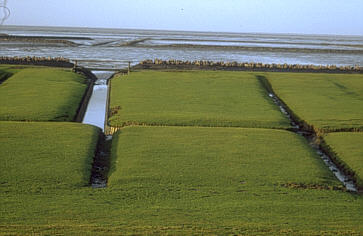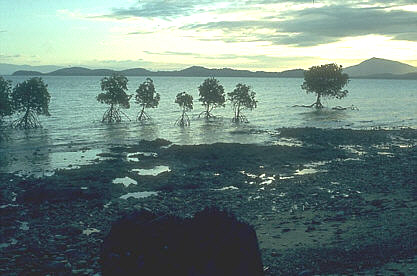Botany online 1996-2004. No further update, only historical document of botanical science!

Ecophysiological aspects allow the differentiation between obligate, facultative, and habitat-indifferent halophytes:
Obligate halophytes grow only in salty habitats. The show a clear optimisation of their development through an increased salt supply in experiments. Many Chenopodiceae belong to this category.
Facultative halophytes are able to settle on salty soils, but their optimum lies in a salt-free or at least low-salt milieu. The salt is tolerated. Most Gramineae, Cyperaceae, and Junaceae as well as a large number of dicotyledons like Glaux maritima, Plantago maritima, Aster tripodium, etc. belong to this group.
Plants that are indifferent toward their habitat are still able to cope with salty soils in nature. They do nevertheless usually live on salt-free soils. They are on one hand able to compete with species that are sensitive towards salt, and are on the other hand able to live on salty soils, too. Examples are Chenopodium glaucum, Myosurus minimus, Potentilla anserina, some grass species, and others. In many species, the populations living on salty soils and those on salt-free soils differ genetically. Examples are : Festuca rubra, Agrostis stolonifera, Juncus bufonius.
Halophytes are often succulent, many species have salt glands, others are able to store considerable concentrations of salt within their vacuole. As soon as 1898, A.F.W. SCHIMPER pointed out that the development of water- and salt storing tissues represents an adaptation to physiological drought. The plants have to cope with a strained water balance as an uptake of water is accompanied by a large uptake of salt. The proteins of halophytes are as a rule not less sensitive to salt than those of other plants. Different strategies are used to cope with high salt:
Succulence. The active concentration of salt in the vacuole and the storage of large volumes of water help to keep the salt concentration of the plasma low.
"Absalztypen". The salt is excreted by salt glands. The salt content of the tissue is low.
Halophytes without a regulating mechanism. The classic example of this type is Juncus gerardii. Its salt content rises steadily throughout one period of vegetation until a limit that is deadly for the plant has been reached. The time is nevertheless long enough for the plant to go through one complete cycle of development.
Root filtering types. An example are mangroves. The quality of the filtering effect fluctuates largely. Some grasses have very efficient filters, while that of succulents are not very effective. The uptake of sodium depends on the membrane and the efficiency of its ion pumps (increased activity of the molecules and/or increased number of pumps per square unit). Salt-tolerant Vitis-species are characterised by a high percentage of phosphatidylcholin in their membranes, the percentage of galactosylglycerin is reduced. It looks, as if these lipids are able to modulate the activity of the pumps.

Halophytes are usually less fit in salt-free habitats than other plants, this is partly due to their relatively slow development. Among the damages of plants caused by salt are:
- Osmotic effects, the uptake of water becomes more difficult.
A disorganisation of the mineral nutrition, the selectivity of the ion uptake disturbed. The ion balance of the cells becomes unbalanced.
Toxic effects: Salt effects. Precipitation or partial denaturation of proteins, changes in their ability to be regulated, changes in the permeability of membranes, etc.